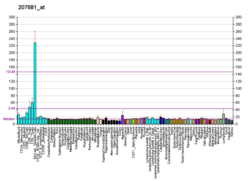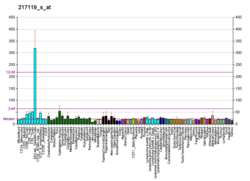Chemokine receptor CXCR3 is a Gαi protein-coupled receptor in the CXC chemokine receptor family. Other names for CXCR3 are G protein-coupled receptor 9 (GPR9) and CD183. There are three isoforms of CXCR3 in humans: CXCR3-A, CXCR3-B and chemokine receptor 3-alternative (CXCR3-alt).[5] CXCR3-A binds to the CXC chemokines CXCL9 (MIG), CXCL10 (IP-10), and CXCL11 (I-TAC)[6] whereas CXCR3-B can also bind to CXCL4 in addition to CXCL9, CXCL10, and CXCL11.[7]
- ^ a b c GRCh38: Ensembl release 89: ENSG00000186810 – Ensembl, May 2017
- ^ a b c GRCm38: Ensembl release 89: ENSMUSG00000050232 – Ensembl, May 2017
- ^ "Human PubMed Reference:". National Center for Biotechnology Information, U.S. National Library of Medicine.
- ^ "Mouse PubMed Reference:". National Center for Biotechnology Information, U.S. National Library of Medicine.
- ^ Altara R, Manca M, Brandão RD, Zeidan A, Booz GW, Zouein FA (April 2016). "Emerging importance of chemokine receptor CXCR3 and its ligands in cardiovascular diseases". Clinical Science. 130 (7): 463–478. doi:10.1042/CS20150666. PMID 26888559.
- ^ Clark-Lewis I, Mattioli I, Gong JH, Loetscher P (January 2003). "Structure-function relationship between the human chemokine receptor CXCR3 and its ligands". The Journal of Biological Chemistry. 278 (1): 289–295. doi:10.1074/jbc.M209470200. PMID 12417585.
- ^ Lasagni L, Francalanci M, Annunziato F, Lazzeri E, Giannini S, Cosmi L, et al. (June 2003). "An alternatively spliced variant of CXCR3 mediates the inhibition of endothelial cell growth induced by IP-10, Mig, and I-TAC, and acts as functional receptor for platelet factor 4". The Journal of Experimental Medicine. 197 (11): 1537–1549. doi:10.1084/jem.20021897. PMC 2193908. PMID 12782716.





